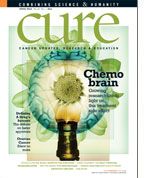A Mouth Full
Oral mucositis can make eating challenging but not impossible.
Mouth sores due to cancer treatment can pose a challenge to eating, but they don’t have to prevent you from getting the nutrition you need to heal and recover.
As one of the most common and uncomfortable side effects of cancer therapy, oral mucositis arises when epithelial cells lining the mouth break down and leave mucosal tissue open to ulceration and infection. Decreased salivation, another potential side effect, can lead to bacterial infections, which is why it’s important to brush your teeth two to three times a day after eating (with a soft-bristle tooth brush) and to use a mild mouth rinse every few hours and at bedtime. Also, avoid commercial mouth washes that contain alcohol, which can be irritating. Ask your nurse or health-care provider to recommend a brand that is designed specifically for people with dry mouth. Prescription antimicrobial rinses, including some that contain pain relievers, or a solution of 1 teaspoon of baking soda mixed with a cup of water may help alleviate discomfort.
Mouth sores can also result in taste changes, pain with eating and subsequent dehydration, so altering food and beverage choices to accommodate new mouth sensitivities is important for proper nutrition and healing. Depending on individual preferences, beverages such as water, non-acidic juices, tea, milk, soy milk and rice milk are good options that won’t irritate sores.
“People may not need to drastically change eating habits, but moisture and softness are the name of the game,” says Suzanne Dixon, MPH, RD, a dietitian and epidemiologist.
Soft or puréed foods that are lukewarm may be easier to eat, since extreme temperatures of hot and cold can irritate mouth sores. “Just steer clear of the obvious culprits, such as citrus, tomato, very dry and very tough foods,” Dixon says. “What is left to choose from is a pretty big selection. The options are limited only by the imagination.”
Instead of completely avoiding toast for breakfast, Dixon suggests dipping it in a liquid, such as milk, to soften it. Adding extra liquid softens food, making it easier to chew and swallow, and helps keep the mouth moist. So, if a favorite casserole calls for one can of soup, use two cans to make the entire dish moister. Dixon also recommends “wet” cooking methods, such as slow cooking or simmering for an extended time with the lid on to make foods softer.
Chicken can be well-tolerated when used in soup or puréed into other items, Dixon says, while potatoes and carrots are good options because they retain their flavors even when cooked soft. Other options include eggs, grilled cheese sandwiches dipped in soup, and smoothies and shakes.
Tricks to add variety include adding non-spicy seasonings and herbs to dishes to change the flavor, such as sprinkling basil or oregano on soups or mashed potatoes. Paula Charuhas Macris, RD, nutrition education coordinator at Seattle Cancer Care Alliance, suggests sucking or chewing on frozen fruit, such as melon balls or peach slices, to soothe painful mouth sores. For some patients, she says, room-temperature liquids like apple juice or pear nectar may be better tolerated.
Patients may need to work with their health-care team to control pain. A few options to discuss include topical anesthetics such as lidocaine and benzocaine, mucosal-coating agents such as Kaopectate (bismuth subsalicylate) and Gelclair (hyaluronate), analgesics such as opioid drugs, and the growth factor agent Kepivance (palifermin). Macris suggests coordinating meals with analgesic use.
The most important thing is to be open to trying new things, which can ensure you get the nutrition you need to heal.
Altering meal frequency and size may make eating less painful as well. Kristin Hamilton, RD, supervisor of clinical nutrition at M.D. Anderson Cancer Center in Houston, says small meals every few hours may be more manageable than larger ones. She suggests eating small amounts—about a quarter of what a normal meal would look like—four to six times a day.
“The most important thing is to be open to trying new things, which can ensure you get the nutrition you need to heal,” Dixon says. “Without sufficient nutrition, the immune system can’t recover and tissues take longer to heal.”
